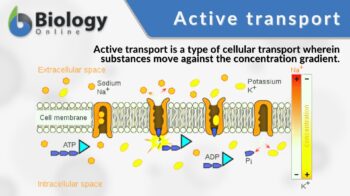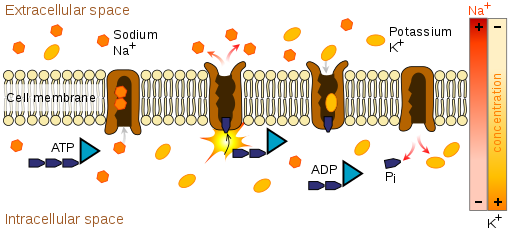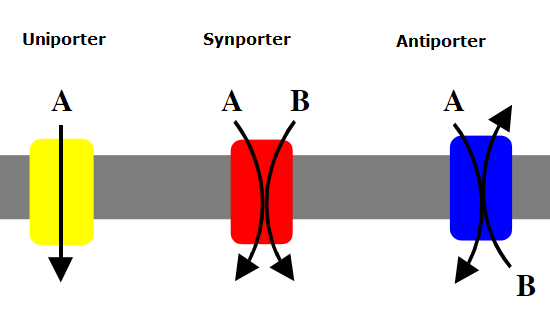
Active transport
n., [ˈæk.tɪv tɹænzˈpɔɹt]
Definition: The “uphill” transport of substances
Table of Contents
Active transport is a type of cellular transport in which substances (e.g. ions, glucose, and amino acids) are transported across a biological membrane towards the region that already contains a lot of such substances. Because of this, active transport uses chemical energy (e.g. ATP) to move such substances against their concentration gradient. The common sites of active transport are root hair cells and the wall of the small intestine (villi).
Active Transport Definition
Active transport is a kind of cellular transport where substances move against a concentration gradient. This means that the direction is from an area of lower concentration to an area of higher concentration. Hence, this process will require the expenditure of energy, and the assistance of membrane proteins, such as carrier proteins.
Active Transport vs. Passive Transport
Passive transport is another form of cellular transport. It is one of the mechanisms employed by a cell to move substances across a biological membrane. It differs from active transport in the way that the substances move not against but along the direction of their respective concentration gradient. The movement of substances in passive transport is in the direction opposite to that of active transport.
In the active transport, substances (e.g. ions, glucose, and amino acids) move across a membrane from a region of their lower concentration to a region of their higher concentration. Thus, they move against the direction of their concentration gradient. Because of this, cellular energy (e.g. ATP) is used in active transport in contrast to passive transport which utilizes kinetic and natural energy. ATP can be generated through cellular respiration.
Types of Active Transport


Active transport may be primary or secondary. A primary active transport is one that uses chemical energy in the form of ATP whereas a secondary active transport uses potential energy often from an electrochemical potential difference. In primary active transport, there is a direct coupling of energy such as ATP. Substances moved in primary active transport are Na+, K+, Mg2+, and Ca2+.
An example is an active transport involving the sodium-potassium pump. It is a transport system in a biological membrane where three Na+ ions are taken out while two K+ ions are taken into the cell against their respective concentration gradients. Another example is the active transport driven by the redox energy of NADH when it moves protons across the inner mitochondrial membrane against the concentration gradient. Photon energy can also drive primary active transport such as when the protons are moved across the thylakoid membrane. This leads to the generation of proton gradients such as during photosynthesis.
In secondary active transport, there is no direct ATP coupling. Rather, the transport is powered by the energy from electrochemical potential difference as the ions are pumped into and out of the cell. In secondary active transport, one ion is allowed to move down its electrochemical gradient. This results in increased entropy that can be used as a source of energy.
For example, Na+ ions moving down the electrochemical gradient across the plasma membrane power up the transport of a second ion against its gradient, e.g. H+ ions. Thus, secondary active transport is also called coupled transport or cotransport. Coupled transport is defined as the simultaneous transport of two substances across a biological membrane. It may be a symport or antiport depending on the direction of movement of the two substances. If both move in the same direction it is a symport type of coupled transport. Conversely, if their movements are in opposite directions it is called antiport.
Primary active transport vs. Secondary active transport | |
|---|---|
| Primary active transport | Secondary active transport |
| Synonym(s): Direct active transport | Synonym(s): Coupled transport or cotransport |
| Direct coupling of ATP | No direct coupling of ATP |
Energy used:
| Energy used:
|
Membrane protein transporter (ion pumps, ion channels, ATPases):
| Cotransporters:
|
Examples:
| Example:
|
Transporters of active transport
In primary active transport, membrane protein transporters include the ion pumps, ion channels, and ATPases. ATPases, in particular, include the P-type ATPases, such as sodium-potassium pump, calcium pump, and proton pump, F-ATPases, such as mitochondrial ATP synthase, chloroplast ATP synthase, and V-ATPases, such as vacuolar ATPase. ATP-binding cassette transporters (ABC transporters), e.g. MDR, CFTR, are also involved in primary active transport. All of them are ATP-driven.
In secondary active transport, the transporters are the antiporters and the symporters. An example of an antiporter is the sodium-calcium exchanger in the membranes of cardiac muscle cells. This antiporter allows three Na+ ions to move down the concentration gradient into the cell and then actively transport one Ca+ ion out of the cell. (1) The movements of Na+ ions and Ca+ ion are in opposite directions.
As for the symport mechanism, an example is the glucose symporter SGLT1 found in the internal lining of the small intestine, the heart, the brain, and the S3 segment of the proximal tubule in each nephron. (2, 3, 4, 5) This transporter moves one glucose (or galactose) molecule along with the two Na+ ions into the cell.
Biological Importance
Active transport is essential in multifarious biological processes. It is employed in many biochemical pathways (e.g. proton gradient generation in chloroplasts and chemosynthesis in mitochondria). In plants, ABC transporter PhABCG1 is responsible for the active transport of volatile organic compounds across the plasma membrane. (6) This is vital to plants since volatile organic compounds entice pollinators and seed-dispersal organisms. Plants also use ABC transporters, particularly NtPDR1, to actively transport antimicrobial metabolites. (7) Plants also employ active transport when they absorb nutrients (e.g. chlorine and nitrates) from the soil into the vacuole. In humans and animals, active transport is employed in many metabolic activities, e.g. glucose absorption.
Answer the quiz below to check what you have learned so far about active transport.
Further Reading
References
- Yu, S. P. & Choi, D. W. (June 1997). “Na(+)-Ca2+ exchange currents in cortical neurons: concomitant forward and reverse operation and effect of glutamate”. The European Journal of Neuroscience. 9 (6): 1273–81.
- Dyer, J., Hosie, K. B., & Shirazi-Beechey, S. P. (July 1997). “Nutrient regulation of human intestinal sugar transporter (SGLT2) expression”. Gut. 41 (1): 56–9. doi:10.1136/gut.41.1.56.
- Zhou, L., Cryan, E. V., D’Andrea, M. R., Belkowski, S., Conway, B. R., & Demarest, K. T. (1 October 2003). “Human cardiomyocytes express high level of Na+/glucose cotransporter 1 (SGLT2)”. Journal of Cellular Biochemistry. 90 (2): 339–46.
- Poppe, R., Karbach, U., Gambaryan, S., Wiesinger, H., Lutzenburg, M., Kraemer, M., Witte, O. W., & Koepsell, H. (July 1997). “Expression of the Na+-D-glucose cotransporter SGLT1 in neurons”. Journal of Neurochemistry. 69 (1): 84–94.
- Wright, E. M. (2001). “Renal Na+-glucose cotransporters”. Am J Physiol Renal Physiol. 280 (1): F10–8. doi:10.1152/ajprenal.2001.280.1.F10
- Adebesin, F. (June 30, 2017). “Emission of volatile organic compounds from petunia flowers is facilitated by an ABC transporter”. Plant Science. 356: 1386–1388.
- Crouzet, J. (April 7, 2013). “NtPDR1, a plasma membrane ABC transporter from Nicotiana tabacum, is involved in diterpene transport”. Plant Molecular Biology. 82 (1–2): 181–192.
© Biology Online. Content provided and moderated by Biology Online Editors







